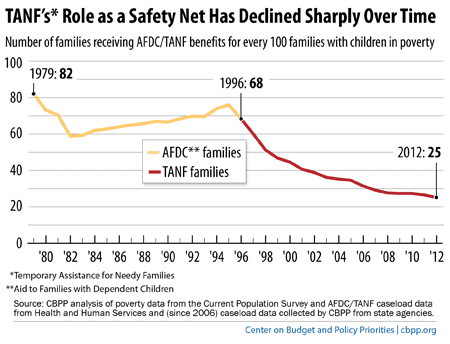BEYOND THE NUMBERS
Eighteen years ago today, President Clinton signed into law the Personal Responsibility and Work Opportunity Reconciliation Act of 1996 — commonly known as “welfare reform.” A key component was its creation of the Temporary Assistance for Needy Families (TANF) block grant to replace Aid to Families with Dependent Children (AFDC).
Since then, TANF has played a shrinking role as a safety net for poor families (see chart), serving a small share of poor families and lifting many fewer families out of “deep poverty” (with incomes below half the poverty line) than AFDC did, as we explain and illustrate in our revised chart book.

A close look at TANF’s track record makes it clear that the program needs retooling to ensure that a strong safety net and sufficient employment assistance is available when people need them most.
Yet some policymakers claim that welfare reform was such an extraordinary success that we should use it as a model for reforming other safety net programs. But the facts don’t make that case. For example, in TANF’s 18-year history, never-married mothers with a high school education or less made substantial gains in employment in only the first four years — largely due to the roaring economy of the late 1990s — and those gains have almost entirely eroded in the subsequent 14. It is wishful thinking to assume that we could see the same employment gains we saw in TANF’s early years in today’s sluggish labor market.
The safety net (other than TANF) plays an extremely important role in reducing poverty and deep poverty in this country — a role that should be maintained. The evidence from TANF suggests that applying TANF-like reforms to other safety net programs would likely cause more families to join the ranks of the deeply poor and cause some who are already deeply poor to become even poorer.
TANF reform is long overdue. We should fix its problems before embarking on reforms that will repeat its failures.
